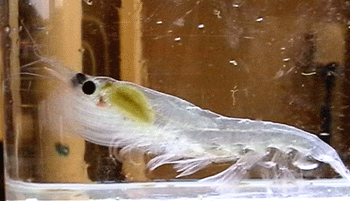Krill research projects
Stevie Davenport & Simon Jarman
The main krill species of interest on this voyage is Euphausia superba. This
species is a transparent, shrimp-like crustacean that grows to about 6 cm long
and is only found in the Southern Ocean. It is important in the Antarctic ecosystem
as so many other animals eat it (eg. many fish, seabirds, seals and whales);
also it is fished commercially by at least 3 nations.
There are three main objectives for krill work on V4:
1. Growth experiments
2. Capture of krill for return to Australian Antarctic Division, Kingston, Tasmania.
3. Automated monitoring of krill abundance and location using hydroacoustics.
 The growth experiments
on board are carried out in the blue IGR box on the trawl deck. (IGR = Instantaneous
Growth Rate). When we catch enough krill for an experiment (104 krill per experiment),
each krill is placed in its own jar and observed daily to see whether it has
moulted.
The growth experiments
on board are carried out in the blue IGR box on the trawl deck. (IGR = Instantaneous
Growth Rate). When we catch enough krill for an experiment (104 krill per experiment),
each krill is placed in its own jar and observed daily to see whether it has
moulted.
Krill, like other crustaceans such as prawns and crabs, have an external shell.
They grow by shedding their old shell. Before the new shell hardens, it is soft
enough to stretch. Euphausia superba moult (shed their old shell) every 20 to
30 days, so we expect to find anywhere between 2 and 10 moults per experiment
per day. Krill that have moulted are removed from their jars, and frozen with
their
moults for measurement back at Kingston.
Typically, the uropods (part of the tail fan) are measured as these remain undamaged
when the animal moults. The instantaneous growth rate is the difference in the
length of the uropod of the moult, and the uropod of the animal that has just
moulted.
A large catch of krill allows us to run several experiments simultaneously.
We can run up to 10 experiments at any one time. Each experiment runs for 5
days. At the end of this time, the remaining krill are returned to one of the
large tanks in Lab 4. Here we continue to give them lots of TLC in the hope
of keeping them alive and healthy for return to Kingston.
The krill that we take back to Kingston are maintained in a special aquarium
that mimics conditions in the Southern Ocean. These krill can then be used for
experiments that cannot be carried out on the Aurora Australis. Currently there
are several experimental programs investigating many aspects of krill biology.
For example, the effects of UV-B radiation on krill, which is particularly relevant
given that the most intense ozone depletion occurs over the Southern Ocean is
under study. The effects of long periods of starvation on krill are being investigated
to help understand how krill survive the long Antarctic winter. To complement
this work, there are experiments on the types of fat that krill use to store
food energy.
 Krill that die
because of old age or the stress of being caught in nets can be used for genetic
or biochemical experiments in Kingston. We are using genetics to investigate
the differences between krill from different parts of the Southern Ocean and
to estimate how fast krill migrate between different areas of the ocean. Biochemical
studies relating to the experiments on the live animals such as investigations
of naturally occurring sunscreens in krill and the nutritional value of krill
to its predators are also underway.
Krill that die
because of old age or the stress of being caught in nets can be used for genetic
or biochemical experiments in Kingston. We are using genetics to investigate
the differences between krill from different parts of the Southern Ocean and
to estimate how fast krill migrate between different areas of the ocean. Biochemical
studies relating to the experiments on the live animals such as investigations
of naturally occurring sunscreens in krill and the nutritional value of krill
to its predators are also underway.
Krill swarms can be detected by hydroacoustics in the same way that fish are
detected with an echosounder. The aurora australis is fitted with three echosounders
that send out 38 Hz, 120 Hz and 500 Hz signals. Krill swarms return a distinctive
acoustic 'signiature' of signals at these frequencies. This system is fully
automated and runs on all voyages of the Aurora Australis allowing us to record
the locations and size of krill swarms in the Southern Ocean at many locations
and times of year.
Simon Jarman is one of the two krill biologists on V4. Normally, he
is a geneticist who lives in Tasmania and is trying to finish a PhD project
on population and evolutionary genetics of krill.
Stevie Davenport is the other of the two krill biologists on V4. She
is a freelance, serendipitous biologist who worked for over 18 years with CSIRO
(shark biology, fisheries, ecosystem studies). Current interests include the
use of stable isotopes as a tool in ecosystem studies.
click on
"Tim the Penguin" to return to Antarctica 1999-2000 Page
